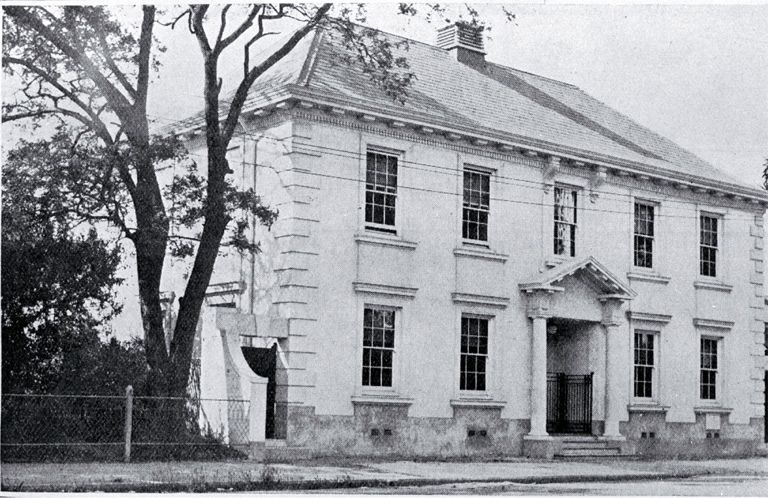Late in the afternoon of 25 July 1926, a crowd gathered at 267 Cambridge Terrace to witness the dedication of a newly erected building. Built in the Neo-Georgian style of architecture, it evoked the image of a palatial dwelling rather than that of a religious institution. At exactly 4:43pm, a time chosen for being the supposed moment when the historical Buddha, Siddhartha Gautama, gave his first sermon at a deer park in Sanarth, India, a dedication stone was unveiled which read:
“This building is dedicated to the Glory of God and to the Service of Humanity.”
Yet the building was neither a Buddhist temple nor a church, but a purpose built hall for a new movement that had arisen in the late nineteenth century, the Theosophical Society.
The Theosophical Society
The Theosophical Society was formed in New York in 1875 by Helena Petrovna Blavatsky (1831-1891), a Russian immigrant, who claimed to have visited Tibet and made contact with a group of secret mystics known as the ‘Masters’. In all likelihood Blavatsky had never visited Tibet (however, her grandfather was the Russian government’s appointed guardian of the Kalmyk people, descendants of Oirat Mongols who had migrated to the Volga steppe of Russia in the seventeenth century and who followed Tibetan Buddhism). Blavatsky managed to convince Henry Steel Olcott (1832-1907), one of the founding members of the New York Confederacy of Spiritualists, as to the existence of the Masters and that she was the recipient of their doctrines. Together they worked to establish a movement of which the objectives were:
To form a nucleus of the universal brotherhood of humanity, without distinction of race, creed, sex, caste, or colour.
To encourage the study of comparative religion, philosophy and science.
To investigate unexplained laws of nature and the powers latent in humanity.
Unable to establish itself on Spiritualist credentials alone, the Theosophical Society soon rebranded itself by appropriating the doctrines of Hinduism and Buddhism. To further this connection with the ancient faiths of India, the society relocated its international headquarters to Adyar, India, in 1882.
Theosophy in Christchurch
Theosophy soon became known in New Zealand through publications and visiting lecturers. Eventually the first lodge was founded in Wellington in 1888, with an Auckland lodge following in 1892.
On 13 May 1894 a meeting was held at the house of William Denne Meers, a clothing manufacturer, with the purpose of forming a Christchurch branch of the Theosophical Society. As a result, the Christchurch lodge was officially established on 28 June 1894. Without any formal premises, the society initially met in rooms at the Opera House at 214 Tuam Street. In the years that followed, the lodge was visited by prominent overseas members, including social reformer Annie Besant (1847-1933) in October 1894 and Henry Steel Olcott in September 1897.
A month after the visit by Olcott, the lodge moved to what was then 130 Lichfield Street, opposite Bennett’s corner. In mid-1900, it relocated to Hobbs’ Buildings on the north side of Cathedral Square (the present site of Tūranga). By 1906, its meetings were held at 150 Worcester Street (opposite the Federal Club). Eventually, in 1910, the lodge took up residence in Manchester Chambers at 263 Manchester Street where it remained until the Cambridge Terrace hall was established.
Sure to Rise
Thomas J. Edmonds (1858-1932) was a successful Christchurch businessman who was most famous for his baking powder and the factory which produced it (now the site of the Edmonds Factory Garden). With his wealth, he contributed to the architecture of the city, with notable examples being the Band Rotunda on Cambridge Terrace and the Radiant Hall on Kilmore Street. Although he was not a member of the Theosophical Society, his daughter Beatrice often attended the society’s meetings. When the society began fundraising for a purpose built hall in 1925, Edmonds offered his financial assistance.
Cecil Wood
The building was designed by prominent architect, Cecil W. Wood (1878-1947) who, from 1922, took an interest in Georgian architecture (one of his notable works being the residence of the Anglican Bishop of Christchurch, Bishopscourt, on Park Terrace). The tender for its construction was awarded to the building firm D. Scott and Son.
While other Theosophical Society halls in New Zealand, such as Wellington (1918) and Auckland (1922) were designed in the Classical architectural style, Wood chose Neo-Georgian for the Christchurch lodge. Constructed from brick, and rectangular in form, the building’s sparse street front was enlivened by the use of multi-paned windows and quoins. Classical elements were still included in the form an entrance framed by a triangular pediment set atop two pillars.
Within, various rooms including a library, kitchen and chapel (for use by the Liberal Catholic Church of Saint Francis) were accessed from a central hallway. At the rear of the building was the central lecture hall, which could seat up to 120 individuals (although it was originally intended to seat more). The second floor of the building eventually became the home of the Christchurch Lodge of Universal Co-masonry and the Esoteric Society.
The end
The Theosophical Society in Christchurch and the Liberal Catholic Church of Saint Francis continued to use the hall until it was damaged in the 2011 Canterbury earthquake. Despite being a heritage listed building, it was subsequently demolished in 2012. Following the demolition of the hall, the Christchurch branch of the Theosophical Society now meets at the Canterbury Workers’ Educational Association building.
Find out more
- Learn about other buildings and monuments in Christchurch associated with Thomas Edmonds.
- Learn more about the architecture of Cecil Wood in our collection or online.
- Read The Secret Doctrine by Helena Blavatsky.





Add a comment to: Riverside Neo-Georgian: The Theosophical Society Hall